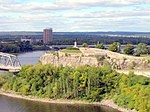Canadian Museum of History

The Canadian Museum of History (French: Musée canadien de l’histoire) is a national museum on anthropology, Canadian history, cultural studies, and ethnology in Gatineau, Quebec, Canada. The purpose of the museum is to promote the heritage of Canada, as well as support related research. The museum is based in a 75,000-square-metre-building (810,000 sq ft) designed by Douglas Cardinal. The museum originated from a museum established by the Geological Survey of Canada in 1856, which later expanded to include an anthropology division in 1910. In 1927, the institution was renamed the National Museum of Canada. The national museum was later split into several separate institutions in 1968, with the anthropology and human history departments forming the National Museum of Man. The museum relocated to its present location in Gatineau in 1989 and adopted the name Canadian Museum of Civilization the following year. In 2013, the museum adopted its current name, the Canadian Museum of History, and modified its mandate to emphasize Canadian identity and history. The museum's collection contains over three million artifacts and documents, with some on display in the museum's permanent exhibitions. The museum also hosts and organizes a number of temporary, travelling, and online exhibitions, like the Virtual Museum of New France.
Excerpt from the Wikipedia article Canadian Museum of History (License: CC BY-SA 3.0, Authors, Images).Canadian Museum of History
Rue Laurier, Gatineau Hull
Geographical coordinates (GPS) Address Website External links Nearby Places Show on map
Geographical coordinates (GPS)
| Latitude | Longitude |
|---|---|
| N 45.429722222222 ° | E -75.708888888889 ° |
Address
Canadian Museum of History
Rue Laurier 100
K1A 0M8 Gatineau, Hull
Quebec, Canada
Open on Google Maps









